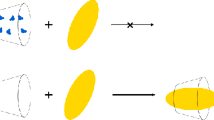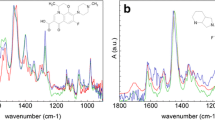Abstract
Context
Hydroxypropyl-β-cyclodextrin (HPβCD) is one of the derivatized cyclodextrins most widely used as an excipient in the pharmaceutical industry, for its capacity to improve certain drugs properties. Different configurations of HPβCD are possible depending on the number and location of the 2-hydroxypropyl groups substituted on the glucose rings. Rifampicin has become the most commonly clinically used antibiotic against tuberculosis in recent years, despite its low solubility and variable bioavailability. Different techniques and materials have been proposed to enhance the properties of rifampicin: cyclodextrin complexation is one of them. The van der Waals term was the main contribution to the interaction energy, which then decisively conditioned the complex configurations. The size of rifampicin did not allow the whole molecule to fit into the host. Moreover, interaction energy was much greater when the guest was located near each rim of HPβCD, where rifampicin was partially included in the cavity and formed inclusion complexes. The piperazine tail of rifampicin was included inside the host in minimum energy structures and the guest was situated near the primary rim of HPβCD in most cases, although the complex configurations depended on the degree of substitution.
Methods
A molecular mechanics simulation based on the GROMOS 53A6 force field was applied in this work to study the inclusion complexes formed by twelve configurations of HPβCD, with different degrees of substitution and rifampicin in water solution. We determined the penetration potential, the complex structures with minimum energies, the possibility of forming inclusion complexes other than those of minimum energies and potential energy surfaces.






Similar content being viewed by others
References
Szejtli J (1998) Introduction and general overview of cyclodextrin chemistry. Chem Rev 98:1743–1754
Saenger W, Jacob J, Gessler K, Steiner T, Hoffmann D, Sanbe H, Koizumi K, Smith SM, Takaha T (1998) Structures of the common cyclodextrins and their larger analogues-beyond the doughnut. Chem Rev 98:1787–1802
Dodziuk H (2006) Cyclodextrins and their complexes: chemistry, analytical methods, applications. Wiley-VCH, Weinheim
Jansook P, Ogawa N, Loftsson T (2018) Cyclodextrins: structure, physicochemical properties and pharmaceutical applications. Int J Pharm 535:272–284
Jambhekar SS, Breen P (2016) Cyclodextrins in pharmaceutical formulations I: structure and physicochemical properties, formation of complexes, and types of complex. Drug Discov Today 21(2):356–362
Lachowicz M, Stańczak A, Kołodziejczyk M (2020) Characteristic of cyclodextrins: their role and use in the pharmaceutical technology. Curr Drug Targets 21:1495–1510
Gieroba B, Kalisz G, Sroka-Bartnicka A, Płazińska A, Płaziński W, Starek M, Dąbrowska M (2021) Molecular structure of cefuroxime axetil complexes with α-, β-, γ-, and 2-hydroxypropyl-β-cyclodextrins: molecular simulations and Raman spectroscopic and imaging studies. Int J Mol Sci 22:5238–5261
Han D, Han Z, Liu L, Wang Y, Xin S, Zhang H, Yu Z (2020) Solubility enhancement of myricetin by inclusion complexation with heptakis-O-(2-hydroxypropyl)-β-cyclodextrin: a joint experimental and theoretical study. Int J Mol Sci 21:766–776
Hua L, Zhanga H, Songa W, Gua D, Hu Q (2012) Investigation of inclusion complex of cilnidipine with hydroxypropyl-β-cyclodextrin. Carbohydr Polym 90:1719–1724
Zia V, Rajewski RA, Stella VJ (2001) Effect of cyclodextrin charge on complexation of neutral and charged substrates: comparison of (SBE)7M-β-CD to HP-β-CD. Pharm Res 18(5):667–673
Patil SM, Barji DS, Chavan T, Patel K, Collazo AJ, Prithipaul V, Muth A, Kunda NK (2023) Solubility enhancement and inhalation delivery of cyclodextrin-based inclusion complex of delamanid for pulmonary tuberculosis treatment. AAPS Pharm Sci Tech 24:49–62
Rayene K, Imane D, Abdelaziz B, Leila N, Fatiha M, Abdelkrim G, Bouzid G, Ismahan L, Brahim H, Rabah O (2022) Molecular modeling study of structures, Hirschfield surface, NBO, AIM, RDG, IGM and 1 HNMR of thymoquinone/hydroxypropyl-β-cyclodextrin inclusion complex from QM calculations. J Mol Struc 1249:131565–131577
Sun X, Chen M, Lei J, Liu X, Ke X, Liu W, Wang J, Gao X, Liu X, Zhang Y (2022) How β-cyclodextrin- loaded mesoporous SiO2 nanospheres ensure efficient adsorption of rifampicin. Front Chem 10:1–10
Kellicia TF, Chatziathanasiadoua MV, Diamantisa D, Chatzikonstantinoua AV, Andreadelisb I, Christodoulouc E, Valsamic G, Mavromoustakosb T, Tzakos AG (2016) Mapping the interactions and bioactivity of quercetin-(2- hydroxypropyl)-β-cyclodextrin complex. Int J Pharm 511:303–311
Junquera E, Martin-Pastor M, Aicart E (1998) Molecular encapsulation of flurbiprophen and/or ibuprophen by hydroxypropyl-β-cyclodextrin in aqueous solution. Potentiometric and molecular modeling studies. J Org Chem 63:4349–4358
Ermondi G, Lavore F, Vallaro M, Tiana G, Vasile F, Caron G (2021) Managing experimental 3D structures in the beyond-rule-of-5 chemical space: the case of rifampicin. Chem Eur J 27:10394–10404
Wicher B, Pyta K, Przybylski P, Tykarska E, Gdaniec M (2012) Redetermination of rifampicin pentahydrate revealing a zwitterionic form of the antibiotic. Acta Cryst C68:o209–o212
Paroha S, Dewangan RP, Dubey RD, Sahoo PK (2020) Conventional and nanomaterial-based techniques to increase the bioavailability of therapeutic natural products: a review. Environ Chem Lett 18:1767–1777
Gayathri NK, Aparna V, Maya S, Biswas R, Jayakumar R, Mohan CG (2017) Preparation, characterization, drug release and computational modelling studies of antibiotics loaded amorphous chitin nanoparticles. Carbohydr Polym 177:67–76
Liu H, He Z-Z, Yu L, Ma J, Jin X-P (2021) Improved solubility and stability of rifampicin as an inclusion complex of acyclic cucurbit[n]uril. J Incl Phenom Macrocycl Chem 101:111–120
Dan Córdoba AV, Aiassa V, Longhi MR, Quevedo MA, Zoppi A (2020) Improved activity of rifampicin against biofilms of Staphylococcus aureus by multicomponent complexation. AAPS Pharm Sci Tech 21:163–176
Dan Córdoba AV, Aiassa V, Dimmer JA, Barrionuevo CN, Quevedo MA, Longhi MR, Zoppi A (2023) Development and characterization of pharmaceutical systems containing rifampicin. Pharmaceutics 15:198–222
Santoveña-Estévez A, Suárez-González J, Cáceres-Pérez AR, Ruiz-Noda Z, Machado-Rodríguez S, Echezarreta M, Soriano M, Fariña JB (2020) Stability study of isoniazid and rifampicin oral solutions using hydroxypropyl-β-cyclodextrin to treat tuberculosis in paediatrics. Pharmaceutics 12:195–208
Inoue Y, Shigematsu M, Komatsu T, Oguchi T, Arce F Jr, See GL (2022) Preparation and spectroscopic characterization of inclusion complexes of 3D ball-milled rifampicin with β-cyclodextrin and γ-cyclodextrin. AAPS Pharm Sci Tech 23:138–153
Anjani QK, Domínguez-Robles J, Utomo E, Font M, Martínez-Ohárriz MC, Permana AD, Cárcamo-Martínez Á, Larrañeta E, Donnelly RF (2022) Inclusion complexes of rifampicin with native and derivatized cyclodextrins: in silico modeling, formulation, and characterization. Pharmaceuticals 15:20–41
Frenkel D, Smit B (2002) Understanding molecular simulation. Academic Press, San Diego, USA
Rapaport DC (1995) The art of molecular dynamics simulation. Cambridge University Press, Cambridge, UK
Alvira E (2022) Theoretical study of structures and charge distributions of 2-, 3- and 6-hydroxypropyl-β-cyclodextrin with different degrees of substitution. J Biomol Struct Dyn 12:180–190
Valiev M, Bylaska EJ, Govind N, Kowalski K, Straatsma TP, Van Dama HJJ, Wang D, Nieplocha J, Apra E, Windus TL, de Jong WA (2010) NWChem: a comprehensive and scalable open-source solution for large scale molecular simulations. Comp Phys Comm 181:1477–1489
Kokalj A (2003) Computer graphics and graphical user interfaces as tools in simulations of matter at the atomic scale. Comp Mater Sci 28:155–168
Oostenbrink C, Villa A, Mark AE, Van Gunsteren WF (2004) A biomolecular force field based on the free enthalpy of hydration and solvation: the GROMOS force-field parameter sets 53A5 and 53A6. J Comput Chem 25:1656–1676
Lins RD, Hünenberger PH (2005) A new GROMOS force field for hexopyranose-based carbohydrates. J Comput Chem 26:1400–1412
Khuntawee W, Karttunen M, Wong-ekkabut J (2017) A molecular dynamics study of conformations of beta-cyclodextrin and its eight derivatives in four different solvents. Phys Chem Chem Phys 19:24219–24229
Funding
This research was funded by the Ministerio de Ciencia e Innovación, under Grant number PID2019-105225 GB-I00.
Author information
Authors and Affiliations
Contributions
E. Alvira, The author confirms sole responsibility for the following: study conception and design, data collection, analysis and interpretation of results, manuscript writing and preparation of figures.
Corresponding author
Ethics declarations
Competing interests
The authors declare no competing interests.
Additional information
Publisher's Note
Springer Nature remains neutral with regard to jurisdictional claims in published maps and institutional affiliations.
Rights and permissions
Springer Nature or its licensor (e.g. a society or other partner) holds exclusive rights to this article under a publishing agreement with the author(s) or other rightsholder(s); author self-archiving of the accepted manuscript version of this article is solely governed by the terms of such publishing agreement and applicable law.
About this article
Cite this article
Alvira, E. Influence of degree of substitution on the hydroxypropyl-β-cyclodextrin complexation with rifampicin in water solution: a molecular simulation. J Mol Model 30, 113 (2024). https://doi.org/10.1007/s00894-024-05916-1
Received:
Accepted:
Published:
DOI: https://doi.org/10.1007/s00894-024-05916-1




